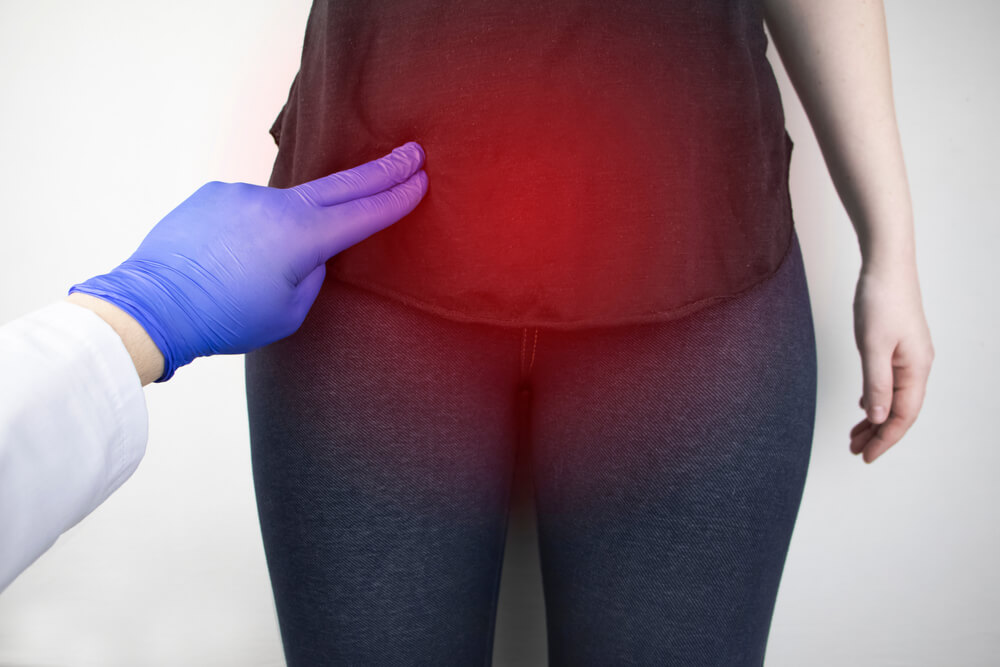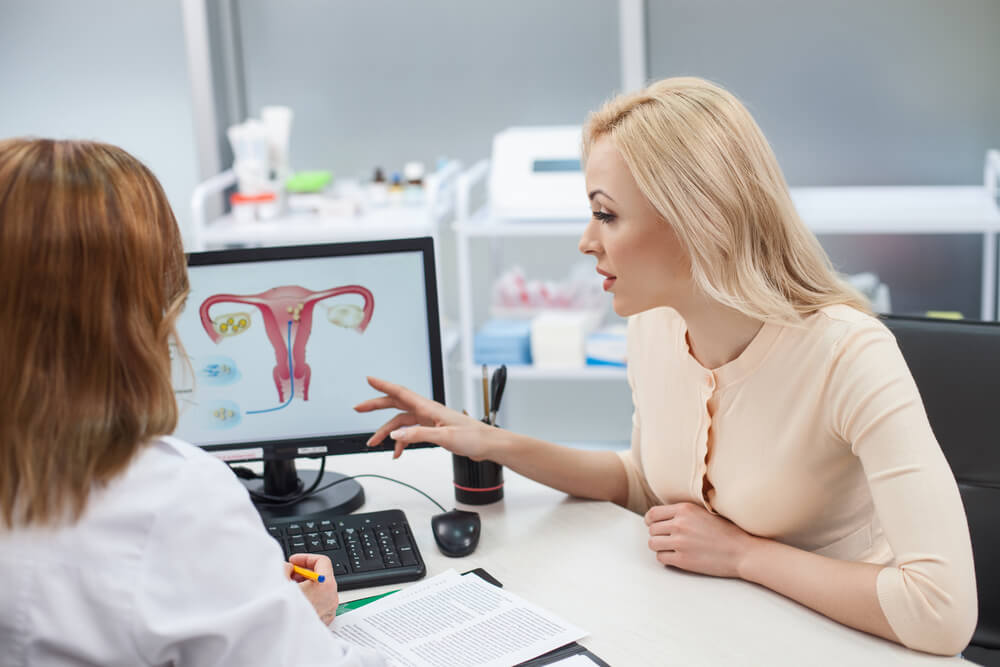Uterine fibroids currently occur in 20-50% of women of reproductive age. Although the growths aren’t cancerous, they can be difficult to deal with in everyday life. They might also have effects on fertility, even without symptoms. Read on to learn more about fibroids and infertility.
Types of Uterine Fibroids
It’s unsettling to discover that there are growths inside one’s uterus. They are also called leiomyomas or myomas, but they’re not all the same. Here are the three main types of fibroids:
- A subserosal fibroid is in the outer uterine wall (55% of cases).
- An intramural fibroid is in the uterine wall’s muscular layers (40% of cases).
- A submucosal fibroid protrudes into the uterine cavity (5% of cases).
The first question many women ask is “What exactly are uterine fibroids?” Simply put, these fibroids are benign (noncancerous) lumps or growths in the smooth muscle tissue of the uterus. That smooth muscle tissue works involuntarily to contract during your menstrual cycle and childbirth. The size, location, and number of fibroids can change the size and shape of the uterus and affect its function.

How Uterine Fibroids Affect Fertility
Since uterine fibroids occur in women during their childbearing years, women naturally want to know whether they will cause fertility issues. Indeed, uterine fibroids increase the risk of infertility and other complications, including pain during pregnancy, miscarriage, or preterm labor. Such risks are alarming for any woman wishing to have children.
Among women facing infertility, about 5-10% have uterine fibroids. For women who are pregnant, 2-12% of women have uterine fibroids, and if they grow, they are most likely to do so during the first trimester.
The connection between fibroids and infertility is strong when the uterine fibroid is larger than 6 centimeters in diameter and especially when the fibroid is submucosal. In such cases, they can change the baby’s position in the uterus, increasing the risk of preterm birth, cesarean section, or miscarriage. They can also cause placental detachment (abruption), causing bleeding and miscarriage.
Uterine fibroids can affect the function of the reproductive organs when they:
- Change the shape of the cervix, preventing sperm from entering into the uterus
- Alter the shape of the uterus, affecting the movement of the sperm or embryo
- Change the thickness of the uterine lining, which is crucial for conception and pregnancy
- Block sufficient blood flow to the uterine cavity, decreasing successful embryo implantation or development
- Are large enough to block fallopian tubes opening into the uterus, preventing successful embryo implantation
How Are Uterine Fibroids Diagnosed?
About 30-35% of women diagnosed with uterine fibroids have symptoms. Some women discover they have uterine fibroids during an ultrasound or a physical exam. For others, it is when they seek medical attention for such symptoms as:
- Long, excessively painful, or heavy periods
- Bleeding between periods
- Severe cramps
- Digestive issues, pain, or pressure in the lower abdomen
- Frequent urination or trouble emptying the bladder
In such instances, an MRI and other tests are necessary for further imaging assessment and diagnosis. Thorough testing helps the doctor determine the number, size, and location of the uterine fibroids and their effects on fertility. The doctor will then discuss treatment options with you to find which ones will work best for your types of fibroids.
Risk Factors for Uterine Fibroids
Genetics, hormones, and environmental factors all contribute to one’s risk of having uterine fibroids. The condition is more common among women who are obese, older, have high blood pressure, have a family history of fibroids, or are Black (50-80%). Other factors include having no history of pregnancy, a vitamin D deficiency, excessive estrogen, and consumption of food additives or soybean milk.
On the other hand, uterine fibroids are less common among women who exercise regularly, manage their weight, and have a healthy diet. They are also less common after the onset of menopause since they are dependent on estrogen. It doesn’t mean, however, that they do not occur. Women who have high hormone levels—estrogen, and especially estrogen and testosterone—in mid-life are more likely to have them. Also, women with uterine fibroids tend to have menopause one to three years later than women without them.
Treatment Options
Uterine fibroids only need treatment when they cause you symptoms and are often too small to be noticeable. You should still get them monitored for any possible growth, however.
If you plan to conceive after fibroid removal, you need to discuss with your doctor the treatment options that will most allow you to do so. Each treatment removes different numbers and sizes of fibroids and affects your fertility differently. All are surgical and are more or less invasive depending on the type.
- Endometrial ablation uses a laser or high-frequency electrical current through a resectoscope to remove the uterine lining. However, it can make conception impossible.
- Uterine artery embolization uses tiny particle injection into the uterus to prevent blood flow to fibroids. It can decrease blood flow to the ovaries and their capacity to provide fertile eggs.
- Myomectomy is the surgical removal of fibroids using abdominal, laparoscopic, robotic, or hysteroscopic methods. It can cause scarring. However, the LAAM technique (Laparoscopic Assisted Abdominal Myomectomy) allows surgeons to remove fibroids without damaging the uterus.
- Hysterectomy is also a possible option, but it is an extreme measure that should be a last resort. You will not be able to conceive, but you might still be able to use your eggs and a surrogate.
If you have been diagnosed with the condition, fertility treatment in Bradenton can help. A less-invasive treatment means less damage to your reproductive organs for a quicker recovery and greater fertility. Ask a specialist about how treatment can increase your ability to get and stay pregnant.

Why Fertility Matters
Having the ability to reproduce is important for many women. Reproductive viability is also important for women’s health in many ways. Even if you decide not to have children, uterine fibroids affect your menstrual cycle, comfort, and quality of life. It is useful to follow your menstrual cycle and keep track of any changes in how you feel.
If you plan to have children, fertility treatment in Bradenton may be the solution you’re looking for. While women might not experience any symptoms from uterine fibroids, others could start to have issues while pregnant or trying to conceive. The prevalence of the condition is based on reported cases, meaning women who sought medical attention and received a diagnosis. Hence, many more women could have uterine fibroids and not know it. Some experts believe up to 80% of women have uterine fibroids.
Although fibroids don’t always need treatment, they do when they affect your daily living and fertility. That’s why it’s so important to get regular gynecological exams and especially to seek medical attention if you are experiencing any possible symptoms of uterine fibroids. Early detection and treatment can drastically improve your fertility.
There Is Hope
Women’s Care of Bradenton is there for you if you have questions or concerns about uterine fibroids. We can find the right treatment options to help improve your fertility. Contact us today for the caring, professional medical attention you deserve.


